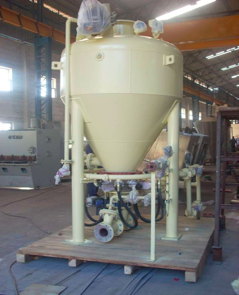Bulkagram 5, June 15
Pneumatic conveying is still somewhat of a black book. There is no foolproof spreadsheet or formula that will give you exact parameters for the operating requirements of a system like air quantities, pressures, material to air ratios, design factors and coefficients etc. Commercially available spreadsheets always have a disclaimer that absolves them of any responsibility if a system designed from their spreadsheet does not perform.
Some of the frequent questions on pneumatic conveying from customers are: “What is the material to air ratio to use?” What is the mode of conveying to use – dense phase or dilute phase” “What is the velocity to use?”
All these questions are interlinked with the material properties like bulk density, particle size distribution, flowability, air retention properties etc of the product to be conveyed. So there are many factors to consider to design the optimum pneumatic conveying system for your particular application.
Let me address just one of these many factors in this Bulkagram: what is dilute phase and what is dense phase pneumatic conveying? Elementary, my dear Watson is what I would love to say: dilute phase is suspension flow and dense phase in non- suspension flow. Suspension flow is when you float particles in a moving air or gas stream. Non suspension flow is when you don’t.
Now anything can be conveyed in dilute phase or suspension flow. All it needs is the correct velocity in the pipeline above saltation. Saltation velocity is the velocity at which the particle will drop out of suspension because there isn’t enough gas or air dynamics to suspend the particle and move it along. You can pneumatically convey elephants or humans as long as you have enough suspension velocity to suspend them in the air stream in the pipe! However, the power needed to create an airstream with enough conveying velocity to suspend them will become economically unviable. You will be talking thousands of kilowatts of power.

Dense phase conveying is totally different. This is non suspension flow: the product is “pushed along the conveying pipe by a wall of air behind it and intermingled with it. All products cannot be conveying in dense phase as compared with the universal nature of dilute phase conveying. Dixon and Geldart researched the nature of such flow and came up with envelopes within which dense phase conveying is possible.
In general, dilute phase suspension flow is a viable option for a range of bulk materials with capacities say upto 20 to 30 tph in an inplant environment. Exceptions in the petrochemicals industry extend that limit further. Dense phase or non-suspension flow is a more choosy method and restricts itself only to a certain combination of bulk materials properties like bulk density, particle size, air retention capacity etc. Cement is an ideal candidate for dense phase conveying for example. You can have phase densities of more than 150 depending on distance and capacity. In self unloading cement ships we have around 500tph over a kilometer or more.
One aspect of dense phase conveying is that the pressure drop across the conveying line influences the terminal and average conveying velocities. The velocity is inversely proportional to the absolute pressure drop across the line. So if you have a pickup velocity of 5m/s and a pressure drop of 4 bar absolute your terminal velocity will be 4 times 5m/s= 20m/s which gets into dilute phase velocity regime. It is optimal to keep the average velocity within 10m/s for which you can step the pipeline diameters along the conveying line to reduce velocity and pressure drop.
As you can see it is quite a bit of permutations and combinations in the pneumatic conveying world. Much of the information, data and technology is with vendors who specialize in this area and it is best that one works with them in confidence for optimal results.
Thankyou!

